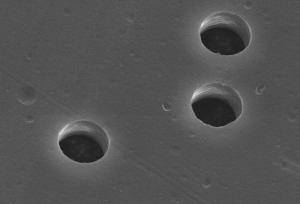This article needs attention from an expert in Engineering. The specific problem is: the article was tagged for copy editing, but to do so requires understanding and this article is too technical. (November 2012) |

Ion tracks are damage-trails created by swift heavy ions penetrating through solids, which may be sufficiently-contiguous for chemical etching in a variety of crystalline, glassy, and/or polymeric solids.[1][2] They are associated with cylindrical damage-regions several nanometers in diameter[3][4] and can be studied by Rutherford backscattering spectrometry (RBS), transmission electron microscopy (TEM), small-angle neutron scattering (SANS), small-angle X-ray scattering (SAXS) or gas permeation.[5]
- ^ D.A. Young (1958). "Etching of radiation damage in lithium fluoride". Nature. 182 (4632): 375–377. Bibcode:1958Natur.182..375Y. doi:10.1038/182375a0. PMID 13577844. S2CID 4282512.
- ^ Cite error: The named reference
Fleischer1975was invoked but never defined (see the help page). - ^
F. Seitz; J.S. Koehler (1956). F. Seitz; D. Turnbull (eds.). "Solid State Physics". Academic Press: 307. LCCN 55012299.
{{cite journal}}: Cite journal requires|journal=(help) - ^ M. Toulemonde; C. Dufour; A. Meftah; E. Paumier (2000). "Transient thermal processes in heavy ion irradiation of crystalline inorganic insulators". Nuclear Instruments and Methods B. 166–167: 903–912. Bibcode:2000NIMPB.166..903T. doi:10.1016/S0168-583X(99)00799-5.
- ^ G. Remmert; Y. Eyal; B.E. Fischer; R. Spohr (1995). "Gas permeability and cross section of latent ion tracks in polymers". Nuclear Instruments and Methods B. 105 (1–4): 197–199. Bibcode:1995NIMPB.105..197R. doi:10.1016/0168-583X(95)00576-5.